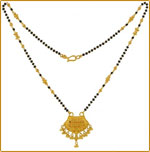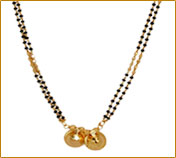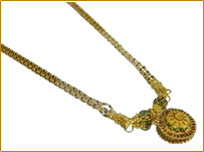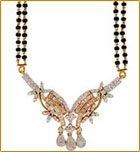
While in some parts of the country it is known as thaaly or maangalyam as in Kannada, Telugu and Tamil in Southern India, people who live in northern part of India call it Mangalsutra. Some people believe that the concept of this sacred thread had its roots laid down in South India. The immense significance and importance in North India as well forms an imperative part of the wedding ceremony.
Mangalsutra serves as the token of dignity and love to the bride by her groom. While marriage the groom ties the Mangalsutra around the neck of the bride and the priest recites Vedic hymns and prays. This tradition of tieing the Mangalsutra signifies the union of the bride and the groom, amidst the presence of deities, who have been believed to be attending the marriage. In some parts of the country, the groom ties the first knot and his sisters tie the rest of the knot. The Mangalsutra is a sacred thread which is made of two strings of small black beads with a locket or pendant. Sometime it is also made up of small beads of gold and black beads, with gold and diamond pendant as per the status of the people engaged in the marriage.
Significance of Mangalsutra in Hindu Marriage

The two strands of black beads of mangalsutra usually symbolize Shiva and Shakti. From the task which are performed by the union of Shiva and Shakti, one of them gains fruit in the form of Chaitanya. This gain of fruit is depicted in the form of the central gold cups that join the strands. The two strands of mangalsutra symbolise duality. Duality means continuity of task. The two strands of the beads are used from this perspective also. The rectangular shaped void created in one part of the two strands of black beads attracts the waves of Energy of Desire.
The nine black beads stringed in each part of the strand symbolise the nine forms of the Primal Energy (Adishakti). The black beads stringed in the gold cord collect the negative vibrations of the attack of negative energies on the body of the woman from time to time and destroy them.
There are seven parts of nine black beads each in both the strands of the mangalsutra. In order to demonstrate these parts, four gold round-shaped beads are arranged in a square shape as a central link. With this the Shakti Principle in the woman remains in a constantly activated state and it is protected from the attacks by negative energies.

Mangalsutra is considered auspicious for married women and is been believed to have divine powers. Each of the black beads which are included in the Mangalsutra, signify protection from evil power and are believed to protect the marriage of a couple from any uncertain happenings and essentially the life of the husband. Hindu women feel superstitious and become uncertain and dejected when this sacred thread breaks or gets lost. In the present modern times the mangalsutra has various designs and patterns.
While the Gujaratis and Marwaris often use designs which are related to diamond pendant, Maharashtrians have a pendant that embibes of one or two vatis and Bengalis have special coral incorporated in the designing of the Mangalsutra.

The black beads in the mangalsutra include waves of the Absolute Earth (Pruthvi-tattva) and Absolute Water (Apa-tattva) elements and the gold beads contain waves of the Absolute Fire element (Tej-tattva). With the union and combination of these waves, Raja-Tama-dominant waves associated with inferior negative energies are been vanished from their origin. Hence, an average woman who wears a mangalsutra has the ability to tolerate the war-like effects of destruction of Raja-Tama-dominant waves.
Present Scenario
Today, in the modern and changing times the concept of wearing a mangalsutra has changed remarkably. Today the Mangalsutra is defined as a fashion statement than a symbol of marriage. With the progressive and developing times wearing of mangalsutra in working women has considerably reduced.
Design and style of making has also changed over the years. In olden days, women used to wear more simpler designs of mangalsutra, with small pendants, but now, the trend is to wear short length ones, that too with a single string. Instead of gold pendants, they are now preferring diamond ones. However the the black beads have still managed to remain constant. Whatever may be the reason to adore it and it might take a fashion statement, mangalsutra surely symbolizes even today the real essence and concept of an Indian marriage.


